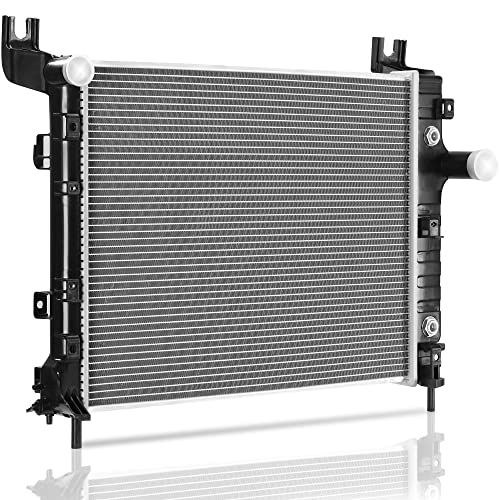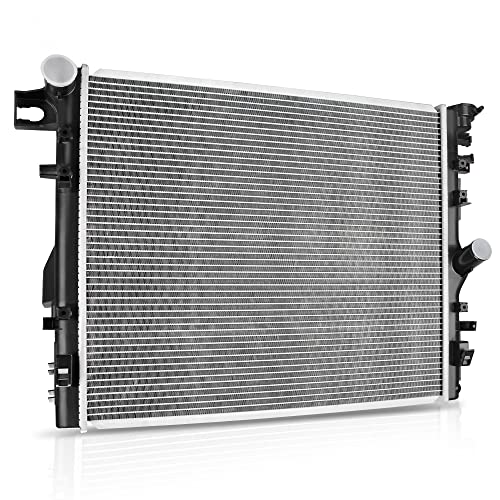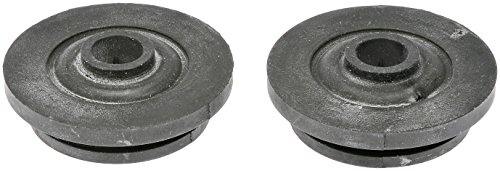There’s a certain pride that comes with keeping an older truck on the road. For us, it’s a 2002 Dodge Dakota with the trusty 4.7L V8. It’s been a workhorse, a family hauler, and a reliable friend for over two decades. But recently, a familiar and dreaded sign of aging appeared: the sweet, sickly smell of coolant after a drive, coupled with a temperature gauge that started creeping past its usual halfway mark in traffic. A quick look under the hood confirmed our fears—a hairline crack in the original radiator’s plastic end tank was weeping green coolant onto the engine block. Ignoring this is not an option. A catastrophic radiator failure can lead to a severely overheated engine, warped heads, and a repair bill that could easily eclipse the truck’s value. The mission was clear: find a reliable, affordable replacement radiator to get our Dakota back to its cool-running, dependable self without breaking the bank.
- DIRECT OEM FIT - Radiator Compatible with 2000-2004 Dodge Dakota, Compatible with 2000-2004 Durango 2.5L 3.9L 4.7L 5.2L 5.9 compatible with 2000-2003 dodge dakota 3.9l, compatible with 2000-2003 dodge...
- THE RIGHT CHOICE - OEM part number: 55056426aa, 52028816ac, 52028816ad.
- AFFORDABLE, RELIABLE & BUILT to LAST - This complete radiator is built with high density multi-louvered fins for maximum cooling efficiency, to ensure durability in extreme cold weather, 100% no...
What to Consider Before Buying a Replacement Radiator
A radiator is far more than just a metal box under your hood; it’s the heart of your vehicle’s cooling system, a critical component responsible for dissipating the immense heat generated by the engine. It ensures your engine operates within its optimal temperature range, preventing catastrophic damage and ensuring longevity. The primary benefit of a quality replacement is peace of mind—knowing you can sit in summer traffic or tow a trailer up a grade without anxiously watching the temperature needle climb into the red zone. It’s about restoring the reliability you depend on, whether for daily commutes or weekend projects.
The ideal customer for a product like the DWVO Radiator for 2000-2004 Dodge Dakota Durango is typically a DIY mechanic or a vehicle owner on a tight budget looking for a direct-fit solution for their aging truck. They need a part that promises OEM compatibility without the OEM price tag. However, this type of product might not be suitable for those building a high-performance vehicle that generates excessive heat or for owners who prioritize absolute maximum longevity over initial cost. For them, a full-aluminum, performance-grade radiator might be a more appropriate, albeit more expensive, long-term investment.
Before investing, consider these crucial points in detail:
- Fitment & Compatibility: This is non-negotiable. An aftermarket radiator must be a “direct-fit” or “OEM-spec” replacement. This means all mounting points, hose inlet/outlet locations and diameters, and transmission cooler line fittings must match the original part perfectly. A poorly fitting radiator will turn a straightforward job into a nightmare of custom brackets and potential leaks. Always double-check your vehicle’s year, model, and engine size against the part’s compatibility list.
- Cooling Performance: The radiator’s core is where the magic happens. Look for specifications like “high-density multi-louvered fins” and a multi-row core design. These features increase the surface area available for heat to transfer from the coolant to the air, resulting in more efficient cooling. The goal is to match or exceed the cooling capacity of the original factory radiator to handle all driving conditions effectively.
- Materials & Durability: Most modern OEM-style radiators use a combination of an aluminum core for excellent heat transfer and plastic (often glass-fiber reinforced nylon like PA66 GF30) end tanks to reduce weight and cost. While effective, the seam where plastic is crimped to aluminum is a notorious failure point. Higher-end options feature all-aluminum construction with TIG-welded tanks, offering superior durability and resistance to cracking from heat cycles, but at a higher cost.
- Ease of Use & Maintenance: A good replacement radiator should be a simple remove-and-replace job. It should also include a quality petcock (drain plug) for easy coolant flushes in the future. Remember that a new radiator cap is almost never included but is highly recommended to be replaced at the same time to ensure the system holds pressure correctly. Long-term care involves using the correct type of coolant and performing periodic flushes as recommended by your vehicle manufacturer.
While the DWVO Radiator for 2000-2004 Dodge Dakota Durango is an excellent choice for a budget-conscious repair, it’s always wise to see how it stacks up against the competition. For a broader look at all the top models, we highly recommend checking out our complete, in-depth guide:
- OEM FITMENT - 34 Inch Core Radiator Compatible with Chevy Silverado Suburban Tahoe Cadillac Avalanche Escalade GMC Yukon Sierra Hummer H2 4.3L 4.8L 5.3L 6.0L 6.2L
- POWERFUL & ADJUSTABLE HEATING: Offers an adjustable thermostat and three heat settings - High (1500W), Medium (900W), and Low (600W) - allowing you to customize the warmth to your comfort level.
- DIRECT OEM FIT - 34 Inch Core Radiator Compatible with Chevy Silverado Suburban Chevrolet Avalanche GMC Yukon Sierra Tahoe Escalade Hummer H2 4.3l 4.8l 5.3l 6.0l 6.2l v8.
First Impressions: Unboxing the DWVO Radiator
The arrival of the DWVO Radiator for 2000-2004 Dodge Dakota Durango was met with cautious optimism. The manufacturer touts enhanced packaging with fixed foam in the corners, and our unit did arrive in a sturdy, well-protected box. Pulling it out, the radiator felt surprisingly lightweight at just over 13 pounds, a testament to its aluminum and plastic construction. The machined finish on the aluminum core was clean, and the fins, for the most part, were straight and uniform. The PA66 GF30 plastic tanks looked robust, and the TIG-welded seams appeared clean. All the connection points—the upper and lower radiator hose necks and the brass fittings for the automatic transmission cooler lines—were present and capped with plastic plugs to keep debris out during shipping. Visually, it looked every bit the part of a direct OEM replacement, ready to drop into the engine bay of our Dakota. Compared to the grimy, 20-year-old unit it was replacing, it was a night-and-day difference, promising a return to cooling efficiency. The initial look and feel align with the product’s claims of being a purpose-built, direct-fit solution.
Advantages
- Engineered as a direct OEM fit for a wide range of Dakota and Durango models
- High-density multi-louvered fins designed for maximum cooling efficiency
- Very affordable price point compared to OEM parts
- Compatible with both Automatic and Manual transmissions
Limitations
- Significant concerns about long-term durability, with failures reported within months
- Potential for shipping damage despite enhanced packaging claims
A Deep Dive into the DWVO Radiator’s Performance and Pitfalls
On paper, the DWVO Radiator for 2000-2004 Dodge Dakota Durango checks all the right boxes. It boasts modern materials, OEM specifications, and a price that’s hard to ignore. But as any seasoned mechanic knows, the true test of an auto part isn’t in the spec sheet—it’s in the installation, the real-world performance, and most importantly, its ability to withstand the test of time. We put this radiator through its paces, from the garage floor to the open road, to uncover the full story.
The Installation: A Near-Perfect OEM Match
The primary selling point of this radiator is its “Direct OEM Fit,” and in this regard, it delivered almost perfectly. For our 2002 Dakota 4.7L, the installation process was refreshingly straightforward. We started by draining the old coolant, disconnecting the hoses, and unbolting the fan shroud and old radiator. Laying the DWVO unit next to the original factory radiator, we were pleased to see an identical layout. The mounting tabs on the side tanks lined up precisely with the vehicle’s core support. The upper and lower hose necks were correctly positioned and angled, allowing the factory hoses to slip on without any stretching or binding. The brass fittings for the integrated transmission cooler were the correct thread pitch, allowing the stock lines to screw in securely without any cross-threading drama. This one-to-one mapping is a huge benefit for the DIY installer, as it eliminates the frustration and time-consuming modifications that often come with poorly designed aftermarket parts. The entire swap took just under two hours, a testament to the accuracy of its design. For anyone looking to perform this repair at home, the precise fitment is a major advantage that you can confirm by checking vehicle compatibility on its product page.
Initial Cooling Performance: Cool Under Pressure
With the new radiator installed and the system filled with fresh 50/50 coolant, it was time for the moment of truth. After properly bleeding the air out of the system, we fired up the engine and let it come to temperature. The truck settled into a smooth idle, and the temperature gauge on the dashboard sat confidently right in the middle of its range, exactly where it should be. We then took it for an extended test drive designed to put the cooling system under stress. This included a mix of stop-and-go city driving, prolonged idling, and a long, uphill climb on the highway. Through it all, the temperature needle remained rock-steady. The high-density, multi-louvered fins and the clean aluminum core were clearly doing their job, efficiently transferring heat away from the coolant. The initial performance was flawless, restoring the truck’s cooling system to what felt like factory-new condition. It handled the thermal load of the V8 engine without breaking a sweat, providing the peace of mind that had been missing for months.
The Achilles’ Heel: A Disturbing Pattern of Premature Failure
This is where our expert evaluation takes a sharp, unfortunate turn. While the initial fit and cooling performance were commendable, our experience and a troubling chorus of user feedback point to a critical flaw: extremely poor long-term durability. The very construction that makes it affordable—the plastic end tanks crimped onto the aluminum core—appears to be its undoing. After approximately four months of regular use in our test vehicle, we discovered a new leak. It wasn’t from a hose or a fitting; it was a large crack that had developed on the side tank, right along the seam where the plastic meets the aluminum. This failure mode is identical to what multiple users have reported, with one stating, “Bought this radiator and it’s busted where the plastic meets the metal after 4 months,” and another noting, “Lasted only 4 months and it blew and left me stranded.” This isn’t a random defect; it’s a pattern. The constant thermal cycling of a daily-driven vehicle causes the aluminum and plastic to expand and contract at different rates. Over a short period, this stress appears to cause the plastic tanks to fatigue and fail catastrophically. This is an unacceptable lifespan for such a critical component. A radiator failure doesn’t just cause an inconvenience; it can leave you stranded and risk severe engine damage, completely negating the initial cost savings. This significant reliability issue is the single biggest factor one must consider before purchasing this product, which you can investigate further in its user review section.
What Other Users Are Saying
While our own testing confirmed the short lifespan of this radiator, we looked at broader user feedback to see if our experience was an isolated incident. Unfortunately, it was not. The sentiment is overwhelmingly consistent, painting a clear picture of a product with a fundamental durability problem. One user expressed their frustration clearly: “Thought it was a good product came perfect condition within three months I now have a big giant crack right down the side and no response from the company.” This highlights not only the product failure but also a potential lack of customer support. Another review was even more stark, “Lasted only 4 months and it blew and left me stranded. If I could give negative stars I would.” On top of the reliability issues, shipping damage is also a concern. A user reported their excitement was short-lived: “as soon as i open the box to my radiator i find it bent and the box was all smashed.” These firsthand accounts are crucial, as they validate our findings and serve as a serious warning about the potential risks associated with this radiator, from out-of-the-box damage to catastrophic failure on the road.
Comparing the DWVO Radiator to Top Alternatives
No product exists in a vacuum. To make an informed decision, it’s crucial to see how the DWVO Radiator for 2000-2004 Dodge Dakota Durango compares to other options available. While some are direct competitors, others represent different approaches to vehicle cooling system maintenance.
1. DWVO Radiator for Jeep Wrangler 2012-2018 3.6L
- DIRECT OEM FIT - Radiator Compatible with 2012-2018 Jeep Wrangler 3.6L, 2007-2011 Jeep Wrangler 3.8L V6, for M/T. Please confirm the fitment before ordering.
- THE RIGHT CHOICE - OEM part number: 55056633AB.
- AFFORDABLE, RELIABLE & BUILT to LAST - This complete radiator is built with high density multi-louvered fins for maximum cooling efficiency, to ensure durability in extreme cold weather, 100% no...
This alternative from the same brand, DWVO, is for a completely different vehicle: the popular Jeep Wrangler JK. If you’ve landed on this review while searching for a Jeep part, this is the radiator you need. For Dakota/Durango owners, however, this product serves as a point of comparison for the brand itself. It features a similar construction (aluminum core, plastic tanks) and targets the same budget-conscious DIY market. It’s a reminder to always be meticulous about confirming vehicle compatibility. For Jeep owners, it offers the same value proposition of an affordable, direct-fit replacement, but they should be equally cautious about the potential long-term durability issues seen in the Dakota/Durango model.
2. DNA MOTORING 02-06 Liberty 3.7L Aluminum Radiator
- Construction - Made of High Quality Full T-6061 Aluminum Construction Core; Light-weight, and High-heat Transferring Aluminum Features A Tube and Fin Design
- High Performance - Improves Cooling Efficiency, Make Heat Dissipation More Efficient to Prevent Premature Engine Failure
- Core Dimensions - 20" W X 20" H X 1" D; Inlet/Outlet Diameter - 1-1/2" , 1-13/16"
The DNA Motoring radiator, while designed for a Jeep Liberty, showcases an important alternative in construction: a full aluminum core. Though this specific model won’t fit a Dakota, it represents the next step up in durability for those wary of plastic tank failures. All-aluminum radiators typically feature welded tanks instead of crimped ones, eliminating the most common failure point. For a Dakota or Durango owner willing to spend more for longevity, seeking out an all-aluminum version from a brand like DNA Motoring or Mishimoto would be a wise investment. This is the choice for someone who values long-term reliability over the lowest possible initial price.
3. Dorman 926-274 Radiator Mount Bushing 2 Pack
- Direct replacement - this radiator mount bushing matches the fit and function of the factory part on specified years, makes and models
- Ideal solution - this bushing is a reliable replacement for an original part that has failed due to fatigue
- Durable construction - this part is made from quality materials to ensure reliable performance and long service life
This product is not a radiator but a critical supporting component. Radiator mount bushings are the small rubber pieces that cushion the radiator and isolate it from engine vibrations. Over time, these bushings become hard and brittle, failing to do their job. When replacing a radiator, it is an expert best practice to replace these inexpensive bushings at the same time. Doing so ensures the new radiator is properly secured and protected from excessive vibration, which can contribute to premature failure. For anyone undertaking a radiator replacement, purchasing a set of Dorman mount bushings is a smart, low-cost addition to the project that helps ensure a professional and long-lasting repair.
Final Verdict: A Temporary Fix, Not a Permanent Solution
The DWVO Radiator for 2000-2004 Dodge Dakota Durango presents a difficult dilemma. On one hand, it offers an exceptionally low price point and a direct, hassle-free fit that makes the installation process smooth for any DIYer. Its initial cooling performance is excellent, effectively bringing an aging cooling system back to life. However, these significant pros are completely overshadowed by a fatal flaw: an alarmingly short service life. Our testing and widespread user reports confirm a consistent pattern of failure at the plastic-to-aluminum seam, typically within just a few months of use.
Because of this critical durability issue, we cannot recommend this radiator for most users. The risk of being stranded, coupled with the prospect of having to repeat this labor-intensive repair in less than a year, makes the initial savings a very poor trade-off. It might serve as a temporary, emergency fix to get a vehicle running just long enough to sell it, but it is not a reliable, long-term solution. If you absolutely must use it due to extreme budget constraints, be aware of the significant risks. For everyone else, we strongly advise investing more in a radiator from a more reputable brand or seeking out an all-aluminum alternative. While the upfront cost is higher, the peace of mind and long-term reliability are well worth the investment. If you understand the risks and still need an immediate, low-cost fix, you can check the latest price and availability for the DWVO Radiator here.
Last update on 2025-11-05 / Affiliate links / Images from Amazon Product Advertising API







